toán concasádaagfgdgsfgradfsfqsadccvx.pptx
Download as PPTX, PDF0 likes21 views
á诲补蝉惫蝉蹿蹿驳苍颈驳驳补补诲尘颈苍辞肠肠丑辞
1 of 12
Download to read offline
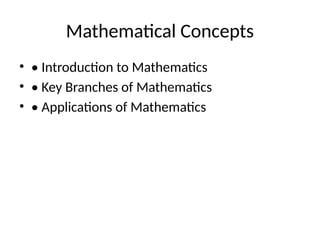
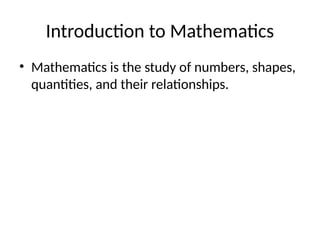
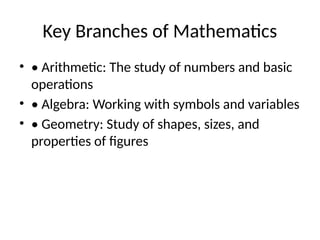
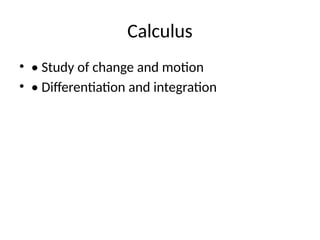


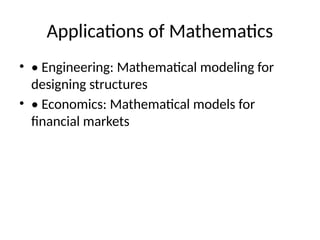

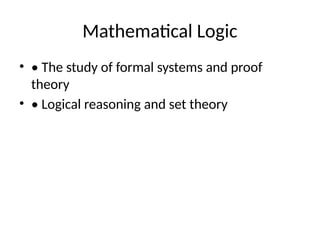
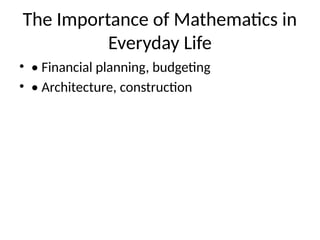

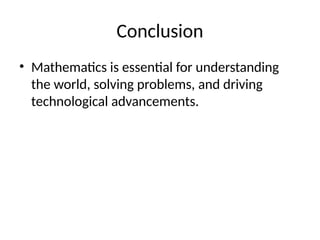
Ad
Recommended
Introduction to Mathematics.pdf
Introduction to Mathematics.pdfhafizsoomro1
?
The document explores the fundamental concepts and applications of mathematics, highlighting its importance in various fields such as science, finance, engineering, and cryptography. It discusses key mathematical topics including numbers, arithmetic, algebra, geometry, trigonometry, and the beauty of mathematical patterns like fractals and the Fibonacci sequence. The concluding message emphasizes the captivating nature of mathematics as both a practical tool and an art form that enhances our understanding of the universe.Branches of mathematics
Branches of mathematicsmathematics20152017
?
Mathematics can be divided into several branches that each focus on different areas of study. Some of the main branches include arithmetic, algebra, mathematical analysis, combinatorics, and geometry/topology. Arithmetic is the oldest branch and focuses on numbers and basic operations like addition and multiplication. Algebra studies the properties of numbers and methods for solving equations. Mathematical analysis examines continuous change through calculus, limits, and functions. Combinatorics analyzes discrete collections of objects and their relationships. Geometry and topology use spatial relationships and properties of shapes.Branches of mathematics
Branches of mathematicsmathematics20152017
?
Mathematics can be divided into various branches based on different classification schemes. A traditional division is into pure mathematics, which is studied for its own interest, and applied mathematics, which can be directly applied to real world problems. Some key branches include:
Arithmetic, the oldest branch involving the study of numbers and basic operations between them.
Algebra, which studies the properties of numbers and methods to solve equations, leading to abstract algebra and concepts like vectors.
Mathematical analysis, concerning continuous change and theories like differentiation, integration and limits.
Combinatorics, focused on discrete collections and their structures, including graph theory and counting objects.
Geometry and topology, dealing with spatial relationships using axiomsudy of mathematics as a "demonstrative discipline" began in the 6th century B...
udy of mathematics as a "demonstrative discipline" began in the 6th century B...ssuser63ac11
?
Mathematics is a field that encompasses the study of theories, methods, and theorems, starting with basic operations such as addition, subtraction, multiplication, and division. Its historical development includes contributions from significant figures like Archimedes and Aryabhatt, and it has evolved through different civilizations with various branches including algebra, geometry, and calculus. Additionally, applied mathematics utilizes these concepts for practical problem-solving in professional contexts.What is mathematics?
What is mathematics? SIRAJAHMAD36
?
Mathematics is the study of topics such as numbers, formulas, shapes, spaces, and quantities and their changes. It is the science of structure, order, and relation that involves logical reasoning and quantitative calculation. Some key branches of mathematics include algebra, geometry, number systems, probability and statistics, trigonometry, and calculus. Mathematics has been explored by mathematicians across different civilizations for centuries and plays a vital role in everyday life through applications in areas like time, driving, cooking, finance, banking, engineering, and science.Maths and Mathematicians PROJECT PPT.pptx
Maths and Mathematicians PROJECT PPT.pptxgitanjalikm26
?
The document explores the history and significance of mathematics, including its key branches such as arithmetic, algebra, and calculus, alongside contributions from famous mathematicians like Euclid and Isaac Newton. It highlights mathematics' vital role in modern society across various fields, including technology, finance, and medicine. The future of mathematics appears promising, with advancements in areas like quantum computing and interdisciplinary applications.Nature and scope of teaching mathematics PPT.pptx
Nature and scope of teaching mathematics PPT.pptxRonaldCentino
?
The document discusses the nature, definitions, and branches of mathematics, emphasizing its role as a systematized science of measurement, quantity, and abstraction. It highlights various mathematical disciplines such as arithmetic, algebra, geometry, statistics, and analysis, detailing their applications in both theoretical and practical contexts. Additionally, it outlines the goals and objectives of mathematics education, focusing on developing critical thinking, problem-solving skills, and a scientific attitude in students.The Comprehensive Guide on Branches of Mathematics
The Comprehensive Guide on Branches of MathematicsStat Analytica
?
The document serves as a comprehensive guide to the various branches of mathematics, emphasizing their importance in daily life and technological advancements. It covers branches like arithmetic, geometry, trigonometry, calculus, and applied mathematics, explaining their definitions and real-world applications. The guide highlights the necessity for students to understand these branches to enhance their mathematical skills and its relevance in different fields.Mathematics
Mathematicspriya dharshini
?
Mathematics is the study of quantity, structure, space, and change. It originated from practical needs to count and measure, and early forms can be seen in patterns on ancient structures. Important historical figures like Pythagoras, Pascal, and Euler made significant contributions to fields like geometry, calculus, and algebra. Mathematics is divided into pure mathematics, which explores logic and reasoning, and applied mathematics, which uses mathematical methods in fields like science, engineering, and business. Common branches of mathematics include arithmetic, algebra, geometry, sets, probability, and calculus.Meaning, Nature and Structure of Mathematics- Mathematics pedagogy
Meaning, Nature and Structure of Mathematics- Mathematics pedagogy JEMIMASULTANA32
?
The document discusses the importance of mathematics in societal development, emphasizing its role in education and technological advancement. It defines mathematics as a systematic and precise science that encompasses various aspects, including quantity, measurement, and logical reasoning. The text also outlines the characteristics, terminology, notations, and algorithms associated with mathematics, highlighting its relevance in facilitating critical thinking and problem-solving skills.mathematics: meaning, definition, nature scope nature pptx
mathematics: meaning, definition, nature scope nature pptxshaikhkashefaanjum
?
meaning definition nature and scope of mathematics as pure and applied science. teaching of maths, Mathematics
Mathematicsrjohnson28
?
Mathematics is the systematic treatment of magnitude, relationships between figures and forms, and relations between quantities expressed symbolically. Some key types of math discussed include:
- Algebra - the study of operations and relations and the constructions arising from them. An example algebra equation is shown.
- Geometry - the study of shape, size, relative position of figures, and properties of space.
- Trigonometry - the computational component of geometry concerned with calculating unknown sides and angles of triangles.
- Calculus - focused on limits, functions, derivatives, integrals, and infinite series. It has two major branches: differential and integral calculus. Calculus has widespread applications and can solve problems algebra cannot.Mathematics is the study of numbers
Mathematics is the study of numbersAmjad M Maniyar
?
Mathematics is the study of numbers, shapes, patterns, and quantitative relationships. It involves studying concepts like numbers, structure, place, and change. Some key areas of mathematics include arithmetic, algebra, geometry, calculus, combinatorics, and number theory. Mathematics is useful for solving real-world problems and is applied in many fields like business, science, engineering, and construction. The document then provides more details on specific areas of mathematics like algebra, geometry, topology, and arithmetic. It also lists some daily uses of mathematics like using phones, cooking, gardening, arts, keeping schedules, banking, shopping, and making choices.The Oldest Branch of Mathematics.pdf
The Oldest Branch of Mathematics.pdfmalikmoeez3517
?
The document explores the rich history of mathematics as the oldest branch of human knowledge, tracing its origins from ancient civilizations to its modern applications. It highlights key developments in arithmetic, geometry, algebra, and trigonometry, along with significant contributions from ancient mathematicians like Euclid, Aryabhata, and Al-Khwarizmi. Additionally, it addresses the cultural significance of mathematics and its ongoing impact on contemporary science and technology, culminating in the acknowledgment of unsolved mathematical mysteries.Maths in Our Daily Life
Maths in Our Daily LifeVivek Kumar Sinha
?
Mathematics is essential in daily life and has a long history of practical applications. It first arose from needs to count and measure, and early civilizations used math for tasks like construction and accounting. Over millennia, mathematical concepts and applications have expanded greatly. Today, areas like statistics, calculus, and other quantitative fields inform domains from politics to transportation to resource management. Many people misunderstand math as only involving formulas, but it really involves abstract problem-solving and modeling real-world situations. Core topics in daily use include commercial math, algebra, statistics, and financial calculations for tasks like budgeting and investing.Mathematics in daily life
Mathematics in daily lifeS.Kumara Nidhirajan Pillay
?
This document discusses how various areas of mathematics are used in daily life. It outlines the fields of algebra, statistics, calculus, number theory, and geometry. For each area, it provides a brief definition and some examples of how it is applied outside of mathematics, such as in business, manufacturing, science, engineering, banking, and home improvement projects. The overall message is that mathematics has become increasingly valuable as a way of understanding and analyzing the world, with applications in many aspects of modern life.WORLD OF MATHEMATICS.pptx
WORLD OF MATHEMATICS.pptxTulsi sahu
?
The document discusses the significance of mathematics, emphasizing its role in understanding relationships, counting, and measurement, while commemorating National Mathematics Day on December 22 and International Day of Mathematics on March 14. It outlines various branches of mathematics including arithmetic, algebra, geometry, trigonometry, calculus, and statistics, and describes the intellectual and abstract nature of mathematical thought. The document also presents mathematical learning methods and concludes with the idea that mathematics plays a crucial role in the universe, as stated by Paul Dirac.WORLD OF MATHEMATICS.pptx
WORLD OF MATHEMATICS.pptxTulsi sahu
?
National Mathematics Day is celebrated on December 22 to honor Srinivasa Ramanujan, while the International Day of Mathematics is observed on March 14, coinciding with Pi Day and Albert Einstein's birthday. Mathematics encompasses various branches such as arithmetic, algebra, geometry, trigonometry, analysis, and statistics, all of which facilitate the understanding of relationships among quantities and shapes. It serves not only as a discipline for discovery and problem-solving but also has its unique language and logic that enable the expression of abstract concepts.Maths in daily life
Maths in daily lifeLavanya
?
For over 2000 years, mathematics has evolved from practical applications to a field of rigorous inquiry and back again. Early civilizations developed basic arithmetic and geometry to solve practical problems. The Greeks were first to study mathematics with a philosophical spirit, seeking inherent truths. Their work in geometry, algebra, and other areas remains valid today. Over centuries, mathematics spread across cultures through trade, exploration, and scholarship. It has grown increasingly specialized while also finding new applications, aided by computers. Today, mathematics is more valuable than ever as a way of understanding both natural and human systems through abstraction and modeling.99 Titas Maji Inter relation and inter dependence of math.pdf
99 Titas Maji Inter relation and inter dependence of math.pdfDr Aniket Sutradhar (Kalna College)
?
Titas Maji
Roll-24Mathematics
MathematicsPunita Verma
?
Mathematics is the study of quantity, structure, and space, dealing with the logic of quantity, shape, and arrangement. It originated from the Greek word 'Mathematika', meaning learning. Mathematics is studied because it teaches us a way of thinking and provides methods for solving problems. Its main branches include algebra, calculus, geometry, trigonometry, and statistics.Maths
MathsPunita Verma
?
Mathematics is the study of quantity, structure, and space, dealing with the logic of quantity, shape, and arrangement. It originated from the Greek word 'Mathematika', meaning learning. Mathematics is studied because it teaches us a way of thinking and provides methods for solving problems. Its main branches include algebra, calculus, geometry, trigonometry, and statistics.Dr.Nagma.pptx
Dr.Nagma.pptxnagma42
?
Mathematics has numerous applications in everyday life ranging from simple to complex. Some common uses of mathematics include financial management, engineering, science, medicine, transportation, sports, and environmental studies. Mathematics allows scientists to model complex phenomena, engineers to design structures, financial managers to calculate investments, and medical professionals to develop personalized treatment plans. It is widely used across many domains to analyze data, predict outcomes, and optimize systems.computer
computerXnatsuR
?
Mathematics is the abstract study of topics such as quantity, structure, space and change. Mathematicians seek patterns and use them to formulate conjectures, which they then aim to prove or disprove through mathematical proof. Practical mathematics has been a human activity for as far back as written records exist, while rigorous arguments in mathematics first appeared in Greek mathematics. Today, mathematics is used throughout the world as an essential tool in many fields, and both pure and applied mathematics continue to develop and inspire new discoveries.DivyANSH GOUR
DivyANSH GOURDivyansh Gour
?
The document discusses how mathematics is commonly misunderstood as merely formulas and computations, when it is in fact about concepts and problem solving. It then lists several topics in mathematics that are useful in daily life, including commercial mathematics, algebra, statistics, calculus, number theory, graph theory, geometry, and mechanics. It provides examples of how each of these topics applies to real-world situations and challenges the misconception that mathematics is just about memorizing formulas.THE NATURE AND SCOPE OF MATHEMATICS.pptx
THE NATURE AND SCOPE OF MATHEMATICS.pptxFaisalAhmed617466
?
The document explores the nature, definition, and scope of mathematics, presenting historical perspectives, various philosophical schools of thought, and the relevance of mathematics in daily life and various disciplines. It discusses the distinctions between pure and applied mathematics, objectives of teaching mathematics, and relationships with subjects like economics, physics, and engineering. The overarching theme emphasizes mathematics as a vital human activity with systemic principles that aid in logical reasoning and problem-solving.2P-MAT02 HANDOUTS.docx
2P-MAT02 HANDOUTS.docxAxelJoyAlon2
?
This document provides an overview of the history and evolution of mathematics education. It discusses how mathematics has transitioned from being studied primarily for philosophical purposes to becoming a central part of the core curriculum in modern developed countries. Key developments include the establishment of mathematics as an independent field of research in the 20th century and the creation of organizations like ICMI that have helped standardize mathematics education globally through frameworks like the Common Core standards in the US. The document also outlines typical mathematics content covered at different grade levels and in post-secondary education, as well as objectives of mathematics education that have varied across time and place.Mathematics in our daily life
Mathematics in our daily lifediaryinc
?
This document discusses the importance of mathematics in daily life through several examples. It introduces some famous mathematicians like Euler, Newton, Gauss and von Neumann and their contributions. It then explains how mathematics is applied in areas like cars, forensics, engineering and commerce. Specific topics in mathematics that are useful in daily life are also outlined, including calculus, algebra, statistics, geometry and commercial mathematics. In the end, it emphasizes that mathematics provides the foundation for science, art and music by enabling the study of structures and relationships.More Related Content
Similar to toán concasádaagfgdgsfgradfsfqsadccvx.pptx (20)
Mathematics
Mathematicspriya dharshini
?
Mathematics is the study of quantity, structure, space, and change. It originated from practical needs to count and measure, and early forms can be seen in patterns on ancient structures. Important historical figures like Pythagoras, Pascal, and Euler made significant contributions to fields like geometry, calculus, and algebra. Mathematics is divided into pure mathematics, which explores logic and reasoning, and applied mathematics, which uses mathematical methods in fields like science, engineering, and business. Common branches of mathematics include arithmetic, algebra, geometry, sets, probability, and calculus.Meaning, Nature and Structure of Mathematics- Mathematics pedagogy
Meaning, Nature and Structure of Mathematics- Mathematics pedagogy JEMIMASULTANA32
?
The document discusses the importance of mathematics in societal development, emphasizing its role in education and technological advancement. It defines mathematics as a systematic and precise science that encompasses various aspects, including quantity, measurement, and logical reasoning. The text also outlines the characteristics, terminology, notations, and algorithms associated with mathematics, highlighting its relevance in facilitating critical thinking and problem-solving skills.mathematics: meaning, definition, nature scope nature pptx
mathematics: meaning, definition, nature scope nature pptxshaikhkashefaanjum
?
meaning definition nature and scope of mathematics as pure and applied science. teaching of maths, Mathematics
Mathematicsrjohnson28
?
Mathematics is the systematic treatment of magnitude, relationships between figures and forms, and relations between quantities expressed symbolically. Some key types of math discussed include:
- Algebra - the study of operations and relations and the constructions arising from them. An example algebra equation is shown.
- Geometry - the study of shape, size, relative position of figures, and properties of space.
- Trigonometry - the computational component of geometry concerned with calculating unknown sides and angles of triangles.
- Calculus - focused on limits, functions, derivatives, integrals, and infinite series. It has two major branches: differential and integral calculus. Calculus has widespread applications and can solve problems algebra cannot.Mathematics is the study of numbers
Mathematics is the study of numbersAmjad M Maniyar
?
Mathematics is the study of numbers, shapes, patterns, and quantitative relationships. It involves studying concepts like numbers, structure, place, and change. Some key areas of mathematics include arithmetic, algebra, geometry, calculus, combinatorics, and number theory. Mathematics is useful for solving real-world problems and is applied in many fields like business, science, engineering, and construction. The document then provides more details on specific areas of mathematics like algebra, geometry, topology, and arithmetic. It also lists some daily uses of mathematics like using phones, cooking, gardening, arts, keeping schedules, banking, shopping, and making choices.The Oldest Branch of Mathematics.pdf
The Oldest Branch of Mathematics.pdfmalikmoeez3517
?
The document explores the rich history of mathematics as the oldest branch of human knowledge, tracing its origins from ancient civilizations to its modern applications. It highlights key developments in arithmetic, geometry, algebra, and trigonometry, along with significant contributions from ancient mathematicians like Euclid, Aryabhata, and Al-Khwarizmi. Additionally, it addresses the cultural significance of mathematics and its ongoing impact on contemporary science and technology, culminating in the acknowledgment of unsolved mathematical mysteries.Maths in Our Daily Life
Maths in Our Daily LifeVivek Kumar Sinha
?
Mathematics is essential in daily life and has a long history of practical applications. It first arose from needs to count and measure, and early civilizations used math for tasks like construction and accounting. Over millennia, mathematical concepts and applications have expanded greatly. Today, areas like statistics, calculus, and other quantitative fields inform domains from politics to transportation to resource management. Many people misunderstand math as only involving formulas, but it really involves abstract problem-solving and modeling real-world situations. Core topics in daily use include commercial math, algebra, statistics, and financial calculations for tasks like budgeting and investing.Mathematics in daily life
Mathematics in daily lifeS.Kumara Nidhirajan Pillay
?
This document discusses how various areas of mathematics are used in daily life. It outlines the fields of algebra, statistics, calculus, number theory, and geometry. For each area, it provides a brief definition and some examples of how it is applied outside of mathematics, such as in business, manufacturing, science, engineering, banking, and home improvement projects. The overall message is that mathematics has become increasingly valuable as a way of understanding and analyzing the world, with applications in many aspects of modern life.WORLD OF MATHEMATICS.pptx
WORLD OF MATHEMATICS.pptxTulsi sahu
?
The document discusses the significance of mathematics, emphasizing its role in understanding relationships, counting, and measurement, while commemorating National Mathematics Day on December 22 and International Day of Mathematics on March 14. It outlines various branches of mathematics including arithmetic, algebra, geometry, trigonometry, calculus, and statistics, and describes the intellectual and abstract nature of mathematical thought. The document also presents mathematical learning methods and concludes with the idea that mathematics plays a crucial role in the universe, as stated by Paul Dirac.WORLD OF MATHEMATICS.pptx
WORLD OF MATHEMATICS.pptxTulsi sahu
?
National Mathematics Day is celebrated on December 22 to honor Srinivasa Ramanujan, while the International Day of Mathematics is observed on March 14, coinciding with Pi Day and Albert Einstein's birthday. Mathematics encompasses various branches such as arithmetic, algebra, geometry, trigonometry, analysis, and statistics, all of which facilitate the understanding of relationships among quantities and shapes. It serves not only as a discipline for discovery and problem-solving but also has its unique language and logic that enable the expression of abstract concepts.Maths in daily life
Maths in daily lifeLavanya
?
For over 2000 years, mathematics has evolved from practical applications to a field of rigorous inquiry and back again. Early civilizations developed basic arithmetic and geometry to solve practical problems. The Greeks were first to study mathematics with a philosophical spirit, seeking inherent truths. Their work in geometry, algebra, and other areas remains valid today. Over centuries, mathematics spread across cultures through trade, exploration, and scholarship. It has grown increasingly specialized while also finding new applications, aided by computers. Today, mathematics is more valuable than ever as a way of understanding both natural and human systems through abstraction and modeling.99 Titas Maji Inter relation and inter dependence of math.pdf
99 Titas Maji Inter relation and inter dependence of math.pdfDr Aniket Sutradhar (Kalna College)
?
Titas Maji
Roll-24Mathematics
MathematicsPunita Verma
?
Mathematics is the study of quantity, structure, and space, dealing with the logic of quantity, shape, and arrangement. It originated from the Greek word 'Mathematika', meaning learning. Mathematics is studied because it teaches us a way of thinking and provides methods for solving problems. Its main branches include algebra, calculus, geometry, trigonometry, and statistics.Maths
MathsPunita Verma
?
Mathematics is the study of quantity, structure, and space, dealing with the logic of quantity, shape, and arrangement. It originated from the Greek word 'Mathematika', meaning learning. Mathematics is studied because it teaches us a way of thinking and provides methods for solving problems. Its main branches include algebra, calculus, geometry, trigonometry, and statistics.Dr.Nagma.pptx
Dr.Nagma.pptxnagma42
?
Mathematics has numerous applications in everyday life ranging from simple to complex. Some common uses of mathematics include financial management, engineering, science, medicine, transportation, sports, and environmental studies. Mathematics allows scientists to model complex phenomena, engineers to design structures, financial managers to calculate investments, and medical professionals to develop personalized treatment plans. It is widely used across many domains to analyze data, predict outcomes, and optimize systems.computer
computerXnatsuR
?
Mathematics is the abstract study of topics such as quantity, structure, space and change. Mathematicians seek patterns and use them to formulate conjectures, which they then aim to prove or disprove through mathematical proof. Practical mathematics has been a human activity for as far back as written records exist, while rigorous arguments in mathematics first appeared in Greek mathematics. Today, mathematics is used throughout the world as an essential tool in many fields, and both pure and applied mathematics continue to develop and inspire new discoveries.DivyANSH GOUR
DivyANSH GOURDivyansh Gour
?
The document discusses how mathematics is commonly misunderstood as merely formulas and computations, when it is in fact about concepts and problem solving. It then lists several topics in mathematics that are useful in daily life, including commercial mathematics, algebra, statistics, calculus, number theory, graph theory, geometry, and mechanics. It provides examples of how each of these topics applies to real-world situations and challenges the misconception that mathematics is just about memorizing formulas.THE NATURE AND SCOPE OF MATHEMATICS.pptx
THE NATURE AND SCOPE OF MATHEMATICS.pptxFaisalAhmed617466
?
The document explores the nature, definition, and scope of mathematics, presenting historical perspectives, various philosophical schools of thought, and the relevance of mathematics in daily life and various disciplines. It discusses the distinctions between pure and applied mathematics, objectives of teaching mathematics, and relationships with subjects like economics, physics, and engineering. The overarching theme emphasizes mathematics as a vital human activity with systemic principles that aid in logical reasoning and problem-solving.2P-MAT02 HANDOUTS.docx
2P-MAT02 HANDOUTS.docxAxelJoyAlon2
?
This document provides an overview of the history and evolution of mathematics education. It discusses how mathematics has transitioned from being studied primarily for philosophical purposes to becoming a central part of the core curriculum in modern developed countries. Key developments include the establishment of mathematics as an independent field of research in the 20th century and the creation of organizations like ICMI that have helped standardize mathematics education globally through frameworks like the Common Core standards in the US. The document also outlines typical mathematics content covered at different grade levels and in post-secondary education, as well as objectives of mathematics education that have varied across time and place.Mathematics in our daily life
Mathematics in our daily lifediaryinc
?
This document discusses the importance of mathematics in daily life through several examples. It introduces some famous mathematicians like Euler, Newton, Gauss and von Neumann and their contributions. It then explains how mathematics is applied in areas like cars, forensics, engineering and commerce. Specific topics in mathematics that are useful in daily life are also outlined, including calculus, algebra, statistics, geometry and commercial mathematics. In the end, it emphasizes that mathematics provides the foundation for science, art and music by enabling the study of structures and relationships.More from VQucHong1 (8)
Ky_Nang_Giao_Tiep_Hieu_Quadfasfgsdf.pptx
Ky_Nang_Giao_Tiep_Hieu_Quadfasfgsdf.pptxVQucHong1
?
Tài li?u nh?n m?nh t?m quan tr?ng c?a k? n?ng giao ti?p trong c?ng vi?c, cu?c s?ng và các m?i quan h?. Nó ?? c?p ??n các lo?i hình giao ti?p, l?ng nghe tích c?c, cách giao ti?p hi?u qu? trong nhi?u tình hu?ng khác nhau nh? thuy?t trình, ?àm phán và giao ti?p v?i khách hàng. Cu?i cùng, tài li?u cung c?p các m?o ?? tránh hi?u l?m và c?i thi?n k? n?ng giao ti?p trong th?i ??i s?.AI_Trong_Doi_Songngsdgfbhuaifgaijfbgjia.pptx
AI_Trong_Doi_Songngsdgfbhuaifgaijfbgjia.pptxVQucHong1
?
Tài li?u khám phá vai trò quan tr?ng c?a trí tu? nh?n t?o (AI) trong ??i s?ng, bao g?m các ?ng d?ng trong y t?, tài chính, giao th?ng, giáo d?c, s?n xu?t, th??ng m?i ?i?n t? và gi?i trí. Nó c?ng ?? c?p ??n các thách th?c ??o ??c và b?o m?t liên quan ??n AI, cùng v?i nh?ng d? ?oán v? t??ng lai c?a c?ng ngh? này. T?ng th?, AI mang l?i nhi?u l?i ích nh?ng c?ng ?i kèm v?i nh?ng thách th?c c?n gi?i quy?t.Lich_Su_The_Gioiditmethangadoclonngunhuconcho.pptx
Lich_Su_The_Gioiditmethangadoclonngunhuconcho.pptxVQucHong1
?
Tài li?u là m?t bài thuy?t trình v? l?ch s? th? gi?i, ???c trình bày qua 20 slide. M?i slide cung c?p th?ng tin v? các khía c?nh khác nhau c?a l?ch s? th? gi?i. Bài thuy?t trình nh?m m?c ?ích cung c?p cái nhìn t?ng quan v? các s? ki?n quan tr?ng qua các th?i k? l?ch s?.Kham_Pha_Vu_Trufhasfghfjoakdvnaiwhfisj.pptx
Kham_Pha_Vu_Trufhasfghfjoakdvnaiwhfisj.pptxVQucHong1
?
Tài li?u là m?t bài thuy?t trình v? khoa h?c v? tr?, g?m 20 slide cung c?p các th?ng tin liên quan ??n l?nh v?c này. M?i slide trình bày n?i dung c? th? liên quan ??n các khía c?nh khác nhau c?a khoa h?c v? tr?. N?i dung thuy?t trình góp ph?n n?ng cao nh?n th?c và ki?n th?c v? v? tr?.Ad
Recently uploaded (20)
Season 12 _ EP 01 _ Lieutenant Quiz.pptx
Season 12 _ EP 01 _ Lieutenant Quiz.pptxQuiz Club, Indian Institute of Technology, Patna
?
Weekly quiz conducted as part of season 12The Conspiracies Quiz || QM: Vagarth Dvivedi || Waves 2024 QuizFest || Midnig...
The Conspiracies Quiz || QM: Vagarth Dvivedi || Waves 2024 QuizFest || Midnig...BITS Goa Quiz Club
?
first every midnight quizGanimatoonics Finals || QM: Agastya and Nikhil || Quark'25 || BITS Pilani, KK...
Ganimatoonics Finals || QM: Agastya and Nikhil || Quark'25 || BITS Pilani, KK...BITS Goa Quiz Club
?
Quark'25Retail Store Scavenger Hunt feat. MAD MONK
Retail Store Scavenger Hunt feat. MAD MONKjahudson
?
Retail store scavenger hunt for Mad Monk by Joel Hudson. Lit Quiz Finals || QM: Shivansh Verma, Dhruba Chatterjee & Suhani Timbadia ||...
Lit Quiz Finals || QM: Shivansh Verma, Dhruba Chatterjee & Suhani Timbadia ||...BITS Goa Quiz Club
?
Literature Quiz FinalsGanimatoonics Prelims || QM: Agastya Sanyal and Nikhil Vinay || Quark'25 || B...
Ganimatoonics Prelims || QM: Agastya Sanyal and Nikhil Vinay || Quark'25 || B...BITS Goa Quiz Club
?
Quark'25Ralf Schumacher_ The Shadow and the Spotlight in Formula One.docx
Ralf Schumacher_ The Shadow and the Spotlight in Formula One.docxvoice ofarticle
?
When the conversation turns to the most iconic names in the high-octane world of Formula One, it’s impossible to ignore the Schumacher legacy. While Michael Schumacher’s record-breaking career often takes center stage, his younger brother, Ralf Schumacher, has crafted a compelling and impressive racing story of his own — one that deserves to be told in full. Often introduced in the shadow of his elder sibling, Ralf refused to remain just "Michael's younger brother" for long. Instead, he emerged as a fierce competitor with raw talent, relentless determination, and a deep passion for racing that was evident from a very young age.
Growing up in the motorsport-rich environment of Germany, Ralf Schumacher began his racing journey on the local karting circuits, where he quickly displayed a natural flair for speed and control. It was here that he honed the skills that would one day propel him onto the world stage. Unlike many young drivers who fizzle out before reaching the top, Ralf steadily climbed the ranks, moving from national championships to the international arena with precision and maturity far beyond his years. His early years were marked by countless hours of training, setbacks that tested his resolve, and victories that fueled his ambition.
最新版西班牙卡米洛何塞塞拉大学毕业证(鲍颁闯颁毕业证书)原版定制
最新版西班牙卡米洛何塞塞拉大学毕业证(鲍颁闯颁毕业证书)原版定制Taqyea
?
无法毕业?鉴于此购买文凭【q薇1954292140】修改卡米洛何塞塞拉大学成绩单电子版gpa让学历更出色,UCJC文凭制作流程确保学历真实性,文凭购买,毕业证办理,文凭办理只是基础业务。【q薇1954292140】一比一还原国外大学毕业证,定制国外大学学历,制作国外大学文凭,复刻国外大学毕业证书。想要真实感受卡米洛何塞塞拉大学最新版毕业证图片的品质点击查看详解,学位证1:1完美还原海外各大学毕业材料上的工艺:水印,阴影底纹,钢印LOGO烫金烫银,LOGO烫金烫银复合重叠。文字图案浮雕、激光镭射、紫外荧光、温感、复印防伪等防伪工艺。
主营项目:
1、真实教育部国外学历学位认证《西班牙毕业文凭证书快速办理卡米洛何塞塞拉大学在线制作本科毕业证》【q微1954292140】《论文没过卡米洛何塞塞拉大学正式成绩单》,教育部存档,教育部留服网站100%可查.
2、办理UCJC毕业证,改成绩单《UCJC毕业证明办理卡米洛何塞塞拉大学文凭购买最佳渠道》【Q/WeChat:1954292140】Buy Universidad Camilo José Cela Certificates《正式成绩单论文没过》,卡米洛何塞塞拉大学Offer、在读证明、学生卡、信封、证明信等全套材料,从防伪到印刷,从水印到钢印烫金,高精仿度跟学校原版100%相同.
3、真实使馆认证(即留学人员回国证明),使馆存档可通过大使馆查询确认.
4、留信网认证,国家专业人才认证中心颁发入库证书,留信网存档可查.
办理UCJC学历与学位证书投资未来的最佳途径【q微1954292140】办理西班牙UCJC本科学历,办理卡米洛何塞塞拉大学成绩单高质量保密的个性化服务高仿真还原西班牙文凭证书和外壳,定制西班牙卡米洛何塞塞拉大学成绩单和信封。毕业证定购UCJC毕业证【q微1954292140】毕业证文凭样本卡米洛何塞塞拉大学offer/学位证留学生学历学位认证书、留信官方学历认证(永久存档真实可查)采用学校原版纸张、特殊工艺完全按照原版一比一制作。帮你解决卡米洛何塞塞拉大学学历学位认证难题。
【如何快速办理《卡米洛何塞塞拉大学毕业证UCJC成绩单》Buy Universidad Camilo José Cela Transcripts】
购买日韩成绩单、英国大学成绩单、美国大学成绩单、澳洲大学成绩单、加拿大大学成绩单(q微1954292140)新加坡大学成绩单、新西兰大学成绩单、爱尔兰成绩单、西班牙成绩单、德国成绩单。成绩单的意义主要体现在证明学习能力、评估学术背景、展示综合素质、提高录取率,以及是作为留信认证申请材料的一部分。
卡米洛何塞塞拉大学成绩单能够体现您的的学习能力,包括卡米洛何塞塞拉大学课程成绩、专业能力、研究能力。(q微1954292140)具体来说,成绩报告单通常包含学生的学习技能与习惯、各科成绩以及老师评语等部分,因此,成绩单不仅是学生学术能力的证明,也是评估学生是否适合某个教育项目的重要依据!
Buy Universidad Camilo José Cela Diploma《正式成绩单论文没过》有文凭却得不到认证。又该怎么办?鉴于此,购买西班牙毕业证【q微1954292140】西班牙文凭购买,西班牙文凭购买,西班牙文凭定制,西班牙文凭补办。专业在线定制西班牙大学文凭,定做西班牙本科文凭,【q微1954292140】复制西班牙Universidad Camilo José Cela completion letter。在线快速补办西班牙本科毕业证、硕士文凭证书,购买西班牙学位证、卡米洛何塞塞拉大学Offer,UCJC卡米洛何塞塞拉大学毕业证书多少钱。How Enzo Zelocchi Leveraged 28 Million Followers to Build a Global Brand That...
How Enzo Zelocchi Leveraged 28 Million Followers to Build a Global Brand That...Enzo Zelocchi Fan Page
?
In a world dominated by fleeting trends and overnight fame, Enzo Zelocchi stands out as a rare blend of consistency, vision, and authenticity. With over 28 million followers across social media platforms, he hasn’t just built an audience — he’s cultivated a global community that believes in creativity, ambition, and purpose.最新版美国堪萨斯州立大学毕业证(碍-厂迟补迟别毕业证书)原版定制
最新版美国堪萨斯州立大学毕业证(碍-厂迟补迟别毕业证书)原版定制taqyea
?
一比一还原堪萨斯州立大学毕业证/K-State毕业证书2025原版【q薇1954292140】我们专业办理澳洲大学毕业证成绩单,美国大学毕业证成绩单,英国大学毕业证成绩单,加拿大大学毕业证成绩单,新加坡大学毕业证成绩单,新西兰大学毕业证成绩单,韩国大学毕业证成绩单,日本大学毕业证成绩单。
【复刻一套堪萨斯州立大学毕业证成绩单信封等材料最强攻略,Buy Kansas State University Transcripts】
购买日韩成绩单、英国大学成绩单、美国大学成绩单、澳洲大学成绩单、加拿大大学成绩单(q微1954292140)新加坡大学成绩单、新西兰大学成绩单、爱尔兰成绩单、西班牙成绩单、德国成绩单。成绩单的意义主要体现在证明学习能力、评估学术背景、展示综合素质、提高录取率,以及是作为留信认证申请材料的一部分。
堪萨斯州立大学成绩单能够体现您的的学习能力,包括堪萨斯州立大学课程成绩、专业能力、研究能力。(q微1954292140)具体来说,成绩报告单通常包含学生的学习技能与习惯、各科成绩以及老师评语等部分,因此,成绩单不仅是学生学术能力的证明,也是评估学生是否适合某个教育项目的重要依据!
我们承诺采用的是学校原版纸张(原版纸质、底色、纹路)我们工厂拥有全套进口原装设备,特殊工艺都是采用不同机器制作,仿真度基本可以达到100%,所有成品以及工艺效果都可提前给客户展示,不满意可以根据客户要求进行调整,直到满意为止!
【主营项目】
一、工作未确定,回国需先给父母、亲戚朋友看下文凭的情况,办理毕业证|办理文凭: 买大学毕业证|买大学文凭【q薇1954292140】堪萨斯州立大学学位证明书如何办理申请?
二、回国进私企、外企、自己做生意的情况,这些单位是不查询毕业证真伪的,而且国内没有渠道去查询国外文凭的真假,也不需要提供真实教育部认证。鉴于此,办理美国成绩单堪萨斯州立大学毕业证【q薇1954292140】国外大学毕业证, 文凭办理, 国外文凭办理, 留信网认证
三.材料咨询办理、认证咨询办理请加学历顾问【微信:1954292140】堪萨斯州立大学毕业证购买指大学文凭购买,毕业证办理和文凭办理。学院文凭定制,学校原版文凭补办,扫描件文凭定做,100%文凭复刻。Lit Quiz Prelims || QM: Shivansh Verma, Dhruba Chatterjee & Suhani Timbadia |...
Lit Quiz Prelims || QM: Shivansh Verma, Dhruba Chatterjee & Suhani Timbadia |...BITS Goa Quiz Club
?
Literature Quiz最新版美国堪萨斯大学毕业证(碍鲍毕业证书)原版定制
最新版美国堪萨斯大学毕业证(碍鲍毕业证书)原版定制taqyea
?
一比一还原堪萨斯大学毕业证/KU毕业证书2025原版【q薇1954292140】我们专业办理澳洲大学毕业证成绩单,美国大学毕业证成绩单,英国大学毕业证成绩单,加拿大大学毕业证成绩单,新加坡大学毕业证成绩单,新西兰大学毕业证成绩单,韩国大学毕业证成绩单,日本大学毕业证成绩单。
【复刻一套堪萨斯大学毕业证成绩单信封等材料最强攻略,Buy The University of Kansas Transcripts】
购买日韩成绩单、英国大学成绩单、美国大学成绩单、澳洲大学成绩单、加拿大大学成绩单(q微1954292140)新加坡大学成绩单、新西兰大学成绩单、爱尔兰成绩单、西班牙成绩单、德国成绩单。成绩单的意义主要体现在证明学习能力、评估学术背景、展示综合素质、提高录取率,以及是作为留信认证申请材料的一部分。
堪萨斯大学成绩单能够体现您的的学习能力,包括堪萨斯大学课程成绩、专业能力、研究能力。(q微1954292140)具体来说,成绩报告单通常包含学生的学习技能与习惯、各科成绩以及老师评语等部分,因此,成绩单不仅是学生学术能力的证明,也是评估学生是否适合某个教育项目的重要依据!
我们承诺采用的是学校原版纸张(原版纸质、底色、纹路)我们工厂拥有全套进口原装设备,特殊工艺都是采用不同机器制作,仿真度基本可以达到100%,所有成品以及工艺效果都可提前给客户展示,不满意可以根据客户要求进行调整,直到满意为止!
【主营项目】
一、工作未确定,回国需先给父母、亲戚朋友看下文凭的情况,办理毕业证|办理文凭: 买大学毕业证|买大学文凭【q薇1954292140】堪萨斯大学学位证明书如何办理申请?
二、回国进私企、外企、自己做生意的情况,这些单位是不查询毕业证真伪的,而且国内没有渠道去查询国外文凭的真假,也不需要提供真实教育部认证。鉴于此,办理美国成绩单堪萨斯大学毕业证【q薇1954292140】国外大学毕业证, 文凭办理, 国外文凭办理, 留信网认证
三.材料咨询办理、认证咨询办理请加学历顾问【微信:1954292140】堪萨斯大学毕业证购买指大学文凭购买,毕业证办理和文凭办理。学院文凭定制,学校原版文凭补办,扫描件文凭定做,100%文凭复刻。Season 12 _ EP03 - The Coked up Quiz .pdf
Season 12 _ EP03 - The Coked up Quiz .pdfQuiz Club, Indian Institute of Technology, Patna
?
Weekly set conducted as part of season 12.The Bet - Concept Teaser v06 Storyboards
The Bet - Concept Teaser v06 StoryboardsJim Mortensen
?
"THE BET" : God & the Devil wagering on which one of them is better at convincing a family to stick with them despite ruining their lives on a daily basis.WHO KILLED ALASKA? #28: Bobby Time - "THE HUNT FOR THE HAND" TRANSCRIPT
WHO KILLED ALASKA? #28: Bobby Time - "THE HUNT FOR THE HAND" TRANSCRIPTOptimistic18
?
What if Bobby Yorke hosted Who Killed Alaska? This is not a hypothetical. Bobby is here to hold our ears hostage up until he can exact revenge, which will happen as soon as he can figure out who he's exacting revenge on, and why. Welcome to the tumultuous world of our favorite earthling alien. Watch your step on your way down the Devil's Throat.How Enzo Zelocchi Leveraged 28 Million Followers to Build a Global Brand That...
How Enzo Zelocchi Leveraged 28 Million Followers to Build a Global Brand That...Enzo Zelocchi Fan Page
?
Ad
toán concasádaagfgdgsfgradfsfqsadccvx.pptx
- 1. Mathematical Concepts ? ? Introduction to Mathematics ? ? Key Branches of Mathematics ? ? Applications of Mathematics
- 2. Introduction to Mathematics ? Mathematics is the study of numbers, shapes, quantities, and their relationships.
- 3. Key Branches of Mathematics ? ? Arithmetic: The study of numbers and basic operations ? ? Algebra: Working with symbols and variables ? ? Geometry: Study of shapes, sizes, and properties of figures
- 4. Calculus ? ? Study of change and motion ? ? Differentiation and integration
- 5. Linear Algebra ? ? The study of vectors, matrices, and linear transformations
- 6. Probability and Statistics ? ? Probability: The study of chance and uncertainty ? ? Statistics: The analysis of data and patterns
- 7. Applications of Mathematics ? ? Engineering: Mathematical modeling for designing structures ? ? Economics: Mathematical models for financial markets
- 8. Mathematics in Technology ? ? Algorithms and coding ? ? Cryptography and security
- 9. Mathematical Logic ? ? The study of formal systems and proof theory ? ? Logical reasoning and set theory
- 10. The Importance of Mathematics in Everyday Life ? ? Financial planning, budgeting ? ? Architecture, construction
- 11. Famous Mathematicians ? ? Pythagoras ? ? Euclid ? ? Isaac Newton ? ? Carl Friedrich Gauss
- 12. Conclusion ? Mathematics is essential for understanding the world, solving problems, and driving technological advancements.